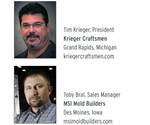Leadtime Leader Q&A: Inspection and Measurement
Moldmaking Technology's 2016 Leadtime Leaders share their views on inspection and measurement.
How extensively do you use inspection and measurement technology in your shop, and where or how do you use it most? Have you invested in any new equipment recently? If yes, tell us about it.
Krieger: I spent a day and a half researching inspection and metrology equipment firsthand during IMTS 2016. It was intriguing to see the world’s finest manufacturers of inspection equipment in one place. I narrowed the decision down to two brands and asked that they each make a presentation to share with my team, whose opinion I greatly value. Following the demonstrations of each product on our molds at the Krieger plant, we invested in a Faro blue light laser scanner and in the reverse engineering software, maintenance and training for both. My vision is to utilize that technology to scan the block before it comes off the machine, inspect it as you go and know that it’s right when it’s delivered for assembly. We don’t have time to rework the rework when delivery seems to always be today, tomorrow, etc.
Bral: We do on-machine inspection of parts, and most of our investments in inspection equipment have been for probes and software to make the inspection process more accurate and efficient. We also have checklists and certain operations that require signatures to make sure items are completed. We continue to research visual inspection equipment to further enhance inspection efficiency and also for reverse engineering purposes. To me, this seems to be the area where scanning systems can be of the most benefit to moldmakers. We often do repair work to molds with no electronic data, and a scanning solution could recreate that data and improve our ability to work on these molds more effectively.
How do you see inspection and measurement tech-nology evolving in the moldmaking industry over the next three to five years?
Krieger: While I don’t want to underestimate the guy who doesn’t have all these fancy systems in place, it’s only going to increase in importance because it’s money—big money—especially when mistakes happen. Therefore, the intent is to attempt to catch mistakes “on the fly” as opposed to finding them when the end product is produced, and avoid additional costs in both time and money, not to mention unnecessary frustration for all involved. Prior to the introduction of standardized measurement to the manufacturing industry, mass chaos occurred and measurement became speculative, and from that, challenges of liability could—and did—arise. Whether you have your own metrology equipment or you have a third-party metrology source that can inspect parts for you, it’s so important to utilize it, and provide evidence of accuracy to valued customers’ engineering teams. It’s also an insurance policy.
Bral: In all honesty, as machines continue to improve in accuracy and quality, and our machining processes and techniques become more robust, I would hope there is a lower reliance on inspection and measurement in the future. Inspection is a non-value-added operation. It’s also not an operation our customers directly pay us to do. If you can cut blocks reliably and know they will come together as intended in the end, there is no need to inspect; but as moldmakers, we need to be sure. The quality check that our customers really care about is that the mold produces the part to print. Whether one side of a shutoff surface is 0.0001-inch heavy and the other side is 0.0001-inch light doesn’t matter to them, as long as it shuts off and the part doesn’t flash. I believe there will always be some level of inspection needed to verify operations were performed correctly, so we won’t totally get away from it
MSI Mold Builders
Related Content
MMT Chats: The Connection Between Additive Manufacturing Education and ROI
This MMT Chat continues the conversation with Action Mold and Machining, as two members of the Additive Manufacturing team dig a little deeper into AM education, AM’s return on investment and the facility and equipment requirements to implement AM properly.
Read MoreDynamic Tool Corporation – Creating the Team to Move Moldmaking Into the Future
For 40+ years, Dynamic Tool Corp. has offered precision tooling, emphasizing education, mentoring and innovation. The company is committed to excellence, integrity, safety and customer service, as well as inspiring growth and quality in manufacturing.
Read MoreMMT Chats: Eliminating the Noise to Stay Focused on the Customer
Metro Mold & Design joins me to discuss the value of the 80/20 rule as a business strategy, its talented cross-functional team, the role of automation in mold building and molding, and the continuing impact of COVID-19.
Read MoreQuestions and Considerations Before Sending Your Mold Out for Service
Communication is essential for proper polishing, hot runner manifold cleaning, mold repair, laser engraving and laser welding services.
Read MoreRead Next
Leadtime Leader Q&A: Krieger Craftsmen and MSI Mold Builders
We invited last year’s Leadtime Leader winner and honorable mention shops to share some of their thoughts about some hot industry topics.
Read MoreHow to Use Continuing Education to Remain Competitive in Moldmaking
Continued training helps moldmakers make tooling decisions and properly use the latest cutting tool to efficiently machine high-quality molds.
Read MoreAre You a Moldmaker Considering 3D Printing? Consider the 3D Printing Workshop at NPE2024
Presentations will cover 3D printing for mold tooling, material innovation, product development, bridge production and full-scale, high-volume additive manufacturing.
Read More




















